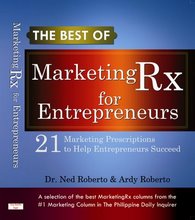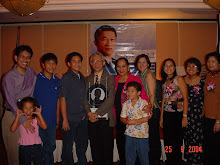MarketingRx for January 29-010
"What should we understand about online consumer buying behavior?"
By Dr Ned Roberto & Ardy Roberto
Q: We're ready to try internet advertising and online marketing. When the internet came around, we recalled that the gateway to the internet for consumers was dialing-up. That technology was very restricting. But the rapid penetration of broadband service allowed consumers quick access to the internet plus fast download and viewing. And today, most consumers are spending more and more time on the internet. In fact, during a conference, we heard you cite a study that found teeners spending 3 hours on the internet for every hour viewing TV.
What should we understand about online consumer buying behavior? We hope you don't mind giving us some simple and practical tips.
A: THE STUDY YOU MENTIONED is the McCann-Erickson research on the youth. This was a survey. So the 3:1 ratio is a claimed proportion. It was a young consumer's estimate when asked the question. So in terms of actual behavior, it's doubtful that the relationship between the two figures is strictly linear. In other words, a youth who's in front of his desktop at home and during those 3 hours is also viewing in the corner of his eyes what's on TV. When something catches his attention on TV, he pauses his chatting or YouTube viewing and gets engaged on the TV program. And then shifts back. Casual observation of this back and forth multi-tasking has been reported with high frequency although we have yet to see its full and systematic documentation.
As to advertising online, we suppose you know that you still remember how this all started with simple banner ads and sponsorships. Simple as they were, they already had a distinct advantage over the traditional advertising. Those banners and sponsorships both were able to link the viewing consumer back to their respective advertiser's web page or promo page. There the consumer could get more information about the ad, the advertised product and the advertiser. That was a rather crude beginning but already an engaging form of interactivity.
In the new and ever changing broadband (and wifi and 3G) technology, the ad campaign has become more sophisticated. There are now video creative features that lend a dynamic character to the ads. It's a sharp contrast to how static were banners of the previous decade of internet ads.
Search Marketing
And now let's go to your question: what to understand about consumer buying behavior when they do internet shopping. Scott Berg, the Worldwide Media Director at Hewlett Packard coined the insighting discipline for this: "search marketing."
The term "search" captures the essence of how an online consumer starts her internet shopping. In this searching behavior, your consumer depends upon her command of "key words." Some have very few, others a whole lot. Those who have a few soon learn more terms. Those who already knew a whole lot also learn much more.
All learn because you, as internet advertiser and marketer, drive them. Just look at how Amazon.com does this with (among others) its recommendations on what other books to buy when buying one title. But this is getting ahead of the game.
Your search marketing program starts or has its key and lead variable in where and how you land in a search engine "listing." The more you are at the top of a page, the more you get click-throughs. Plus this: The more relevant consumers find you in the listing, the more your click-throughs. Or at least these two are what almost all of us in cyber space marketing assumes to be the case.
As you can see, here what is critical to understand about the internet shoppers is what key words and terms they will use and are learning in their search buying. That defines the insighting research you have to do and keep on doing. We say "keep on doing" because there's continuing learning among consumers.
Exciting CUR issues
When you get into this kind of consumer understanding research (CUR), the findings often challenges your assumptions. That includes our assumption that being on top of the list is where the premium shopper "real estate" is to be found. It's analogous to our own supermarket shopper in-store behavior study. In most cases, that premium shelf location in the supermarket turns out to be not the entrance to the aisle but the shelf space that's in the shopper's second or third step as she enters. This is because in most cases, she gets into an aisle fast and then slows down on her second or third step.
In any case, this is the kind exciting CUR issues you are up against. But your raising the question tells us you're way ahead of other online advertisers and marketers who are proceeding with their search marketing campaign with "rules-of-thumb" and unvalidated internet consumer behavior assumptions. As Berg says in his HP blog post, Digital Ignorance, education is key for marketers (especially the CMO) in this day and age of digital marketing. Make sure that you continue asking questions AND continue searching for answers from different sources.
Please keep your questions coming. Send them to us at drnedmarketingrx@gmail.com or MarketingRx@pldtDSL.net. God bless!










No comments:
Post a Comment